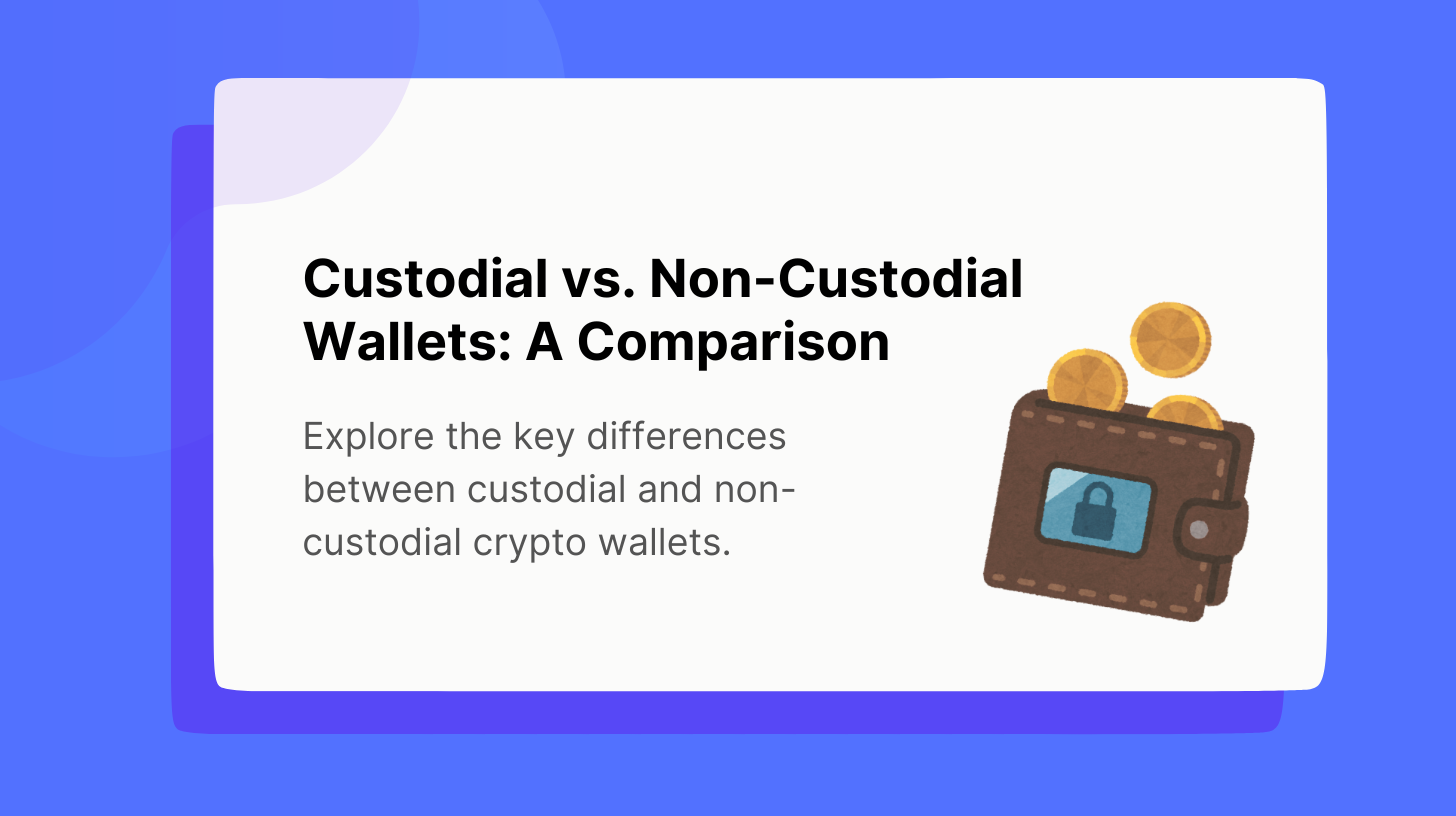Custodial Wallets
Definition and Description
A custodial wallet gives private keys to an external entity, such as a cryptocurrency exchange or a dedicated wallet service. These private keys are the cryptographic credentials required to access and manage the associated cryptocurrency holdings. By giving up control of these keys, users give the third party full control of their digital assets. The service provider is in charge of completing transactions for the user, keeping security protocols, and keeping the funds safe. This arrangement is similar to traditional banking, where individuals entrust their money to financial institutions that manage and protect their deposits. Custodial wallets offer a similar sense of security and convenience to cryptocurrencies, particularly for those who may not be well-versed in the technical aspects of blockchain and cryptocurrency management.
Advantages
- Ease of Use: For beginners and less tech-savvy individuals, custodial wallets provide a user-friendly interface and simplified transaction processes. Users do not need to worry about managing private keys or understanding complex blockchain operations.
- Free Transactions: Many custodial wallet services offer free transactions within their ecosystem, making it cost-effective for users to transfer funds or make payments.
- Easy Recovery: In the event of lost access credentials or forgotten passwords, custodial wallets offer straightforward recovery options, as the service provider can reset account access based on user verification.
- Backup Facilities: The centralized nature of custodial services allows for robust backup and recovery systems, ensuring that user data and funds can be restored in case of technical difficulties or accidental loss.
Disadvantages
- Third-Party Control: The most significant drawback of custodial wallets is the surrender of control to an external entity. Users should trust the service provider to handle their money safely and ethically.
- KYC Requirements: To comply with regulatory standards, custodial wallets often require users to undergo Know Your Customer (KYC) procedures, which can compromise the anonymity that many seek in the cryptocurrency space.
- Data Breach Risks: Centralized systems, like those of custodial wallets, are attractive targets for hackers. A breach in the service provider’s security could lead to the loss or theft of users’ funds, as seen in several high-profile incidents in the past.
Examples
- Binance: As one of the largest cryptocurrency exchanges globally, Binance offers a custodial wallet service with advanced security measures, including two-factor authentication (2FA) and cold storage for the majority of user funds.
- Blockchain.com: Known for its user-friendly interface, Blockchain.com’s wallet service includes options for buying, selling, and swapping cryptocurrencies directly within the wallet, along with robust security protocols to protect user assets.
Non-Custodial Wallets
Definition and Description
Non-custodial wallets are characterized by the fact that users retain full control over their private keys and, consequently, their cryptocurrency assets. In this setup, the private keys are usually saved on the user’s device or encrypted in the wallet app. This direct control means that users are solely responsible for executing transactions, managing their security, and ensuring the safekeeping of their private keys. Non-custodial wallets follow the decentralized philosophy of cryptocurrency, which emphasizes individual freedom and privacy. By eliminating the need for a third-party intermediary, these wallets empower users to interact directly with blockchain networks.
Advantages
- User Control: The primary advantage of non-custodial wallets is the complete control they offer users over their funds. This autonomy allows for greater flexibility in managing and transferring assets.
- Lower Data Breach Risk: Since private keys are stored locally and not on centralized servers, non-custodial wallets are less susceptible to large-scale data breaches that can compromise user funds.
- Privacy: Non-custodial wallets often require minimal personal information, providing a higher degree of anonymity compared to custodial wallets that may enforce KYC procedures.
Disadvantages:
- Lack of Recovery Options: If a user loses their private key or mnemonic phrase, there is typically no way to recover access to their funds. This permanence can be daunting for some users.
- User Responsibility: With great control comes great responsibility. Users of non-custodial wallets must be diligent in safeguarding their private keys and staying informed about security best practices to avoid potential losses.
Examples
Several non-custodial wallets have become popular for their user-friendly interfaces and robust security features.
- Exodus is a popular wallet that can hold many different currencies. It looks nice and is easy to use, even for people who are new to it. It also offers integration with the Trezor hardware wallet for enhanced security.
- Metamask: Primarily known as an Ethereum wallet, Metamask serves as a gateway to decentralized applications (dApps) on the Ethereum network. It is available as a browser extension and a mobile app, offering users a seamless experience when interacting with the Ethereum ecosystem.
Comparison of Custodial and Non-Custodial Wallets
The decision between custodial and non-custodial wallets is a fundamental decision for anyone involved in the cryptocurrency space. Each type of wallet offers a distinct set of features, benefits, and trade-offs that cater to different user needs and preferences.
| Feature | Custodial Wallets | Non-Custodial Wallets |
|---|---|---|
| Security | Higher security measures, but risk of centralization | User-dependent security reduces the risk of large-scale breaches. |
| Privacy | Less privacy due to potential KYC requirements | Greater privacy; no need for personal information |
| Control and Ownership | Less control, third-party manages funds | Full control and ownership of funds |
| User Experience and ease of Use | Generally easier for beginners, streamlined interfaces | More flexibility, requires technical knowledge |
| Flexibility and Interoperability | Limited interaction with dApps, integrated services | Greater flexibility and direct interaction with dApps and blockchain networks |
| Cost and Fees | May charge service fees, but offers conveniences like free transfers | Lower fees for transactions, but network fees apply |
Security and Privacy
When it comes to security and privacy, custodial and non-custodial wallets present different considerations. Custodial wallets, managed by third-party services, often implement robust security measures, including regular security audits, multifactor authentication, and cold storage for the bulk of assets. However, the centralized nature of these wallets can make them attractive targets for hackers, and users must trust the service provider to protect their privacy and handle their data responsibly.
Non-custodial wallets, on the other hand, offer greater privacy since users are not required to share personal information or undergo KYC procedures. Security in non-custodial wallets is largely user-dependent; individuals are responsible for safeguarding their private keys and ensuring the security of their devices. While this provides a higher degree of privacy, it also means that the risk of loss due to user error or a lack of security awareness is higher.
Control and Ownership
The trade-off between control and convenience is a key factor in choosing between custodial and non-custodial wallets. Non-custodial wallets grant users full control and ownership of their funds, allowing for direct interaction with blockchain networks without intermediaries. This level of control is good for people who want to be in charge and avoid the risks of third-party management.
Custodial wallets, while offering less control, provide a more user-friendly experience, making them suitable for beginners or those who prefer a hands-off approach to managing their cryptocurrency. The convenience of having a third party handle security, backup, and recovery processes can be a significant advantage for users who prioritize ease of use over absolute control.
User Experience and Ease of Use
In terms of user experience and ease of use, custodial wallets generally offer a more streamlined and intuitive interface, simplifying the process of buying, selling, and transferring cryptocurrency. This can be especially appealing to newcomers to the cryptocurrency world, who may find the technical aspects of managing a non-custodial wallet daunting.
Non-custodial wallets, while offering more flexibility and control, often require a higher level of technical knowledge and diligence from the user. The need to manage private keys and understand the workings of blockchain transactions can pose challenges for less experienced users.
Flexibility and Interoperability
Flexibility and interoperability are important considerations when comparing wallet types. Non-custodial wallets typically provide greater flexibility, allowing users to interact with a wide range of decentralized applications (dApps), smart contracts, and various blockchain networks. This interoperability is crucial for users who engage in activities such as yield farming, token swapping, and participating in decentralized finance (DeFi) platforms.
Custodial wallets, while sometimes limited in terms of direct interaction with dApps and other blockchain services, typically offer integrated solutions that streamline the user experience. For example, some custodial wallets provide built-in exchanges, lending services, and support for multiple cryptocurrencies, making it easier for users to manage their assets across different platforms.
Cost and Fees
The cost and fees associated with using custodial and non-custodial wallets can vary significantly. Custodial wallets may charge fees for transactions, withdrawals, and other services, but they also typically offer conveniences like free transfers within the platform’s ecosystem. Additionally, the cost of security and infrastructure is typically borne by the service provider.
Non-custodial wallets may have lower fees for transactions, as they do not involve intermediary services. However, users must pay network fees for transactions on the blockchain, which can vary depending on network congestion and the chosen cryptocurrency. Additionally, users of non-custodial wallets may incur costs related to securing their devices and backing up their private keys.
In conclusion, the choice between custodial and non-custodial wallets depends on individual preferences and priorities. Those who value security, privacy, and control may opt for non-custodial wallets, while those seeking convenience, ease of use, and integrated services might prefer custodial wallets. Understanding the trade-offs and features of each type of wallet is essential for making informed decisions in the dynamic world of cryptocurrency.
Conclusion
The choice between custodial and non-custodial wallets is a pivotal decision for anyone engaged in the world of cryptocurrency. This decision depends on many factors, such as the user’s priorities, technical expertise, and willingness to take risks.
Custodial wallets offer a more user-friendly experience, with third-party services managing the complexities of security and transactions. They provide convenience and ease of use, particularly for beginners or those who prefer a hands-off approach to managing their digital assets. However, this convenience comes at the cost of relinquishing control and privacy, as users must trust the service provider to safeguard their funds and personal information.
On the other hand, non-custodial wallets empower users with full control over their private keys and, consequently, their cryptocurrency holdings. This autonomy enhances security and privacy, as users are not reliant on a centralized entity. However, it also places the responsibility of managing and securing the wallet squarely on the user’s shoulders, requiring a higher level of technical knowledge and diligence.
When choosing between custodial and non-custodial wallets, it is essential for users to assess their needs and preferences. Factors such as the level of security desired, the importance of privacy, the need for convenience, and the user’s comfort with technology should all be considered. Additionally, users should evaluate the features and reputation of specific wallet providers to ensure they align with their requirements.
Finally, regardless of the type of wallet picked, it is crucial for users to engage in ongoing learning about wallet security and responsible cryptocurrency management. The landscape of digital assets is continually evolving, and staying informed about best practices, emerging threats, and new technologies is key to safeguarding one’s investments and navigating the cryptocurrency ecosystem with confidence.





